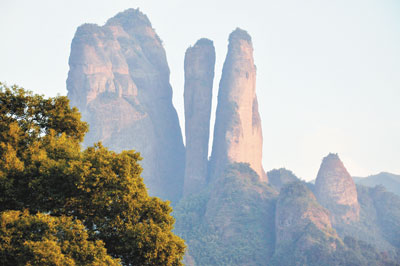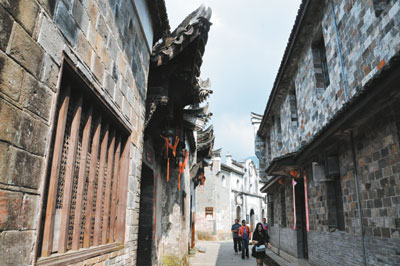Han Ximin 
ximhan@126.com JUST a 90-minute flight from Shenzhen, Quzhou City in Zhejiang Province feels like another world with its abundance of cultural relics that preserve its long history. The 1,800-year-old city has a population of just 2.52 million. Yet the prefecture-level city, 70 percent of which is covered in forest, is four times bigger than Shenzhen. Jianglang Mountain Quzhou is located in the west of Zhejiang, and has borders with Fujian, Jiangxi and Anhui provinces. Qujiang River is the source of Qiantang River, a river which enters into the Yellow Sea on the east coast of the province. Jianglang Mountain, the only UNESCO world natural heritage site in Zhejiang Province, is located in this ancient city. Xu Xiake, a noted traveler and geographer of the late Ming Dynasty (1368-1644), traveled to Jianlang Mountain three times, in 1620,1628 and 1630. In his travelogue, he noted: “Looking far eastward, I saw an extremely high peak, scraping the sky and ready to fly… Approaching it, I found it suddenly split into two, then into three… Its shape changed every step you moved like the magic clouds above!” But he left disappointed as he couldn’t climb to any of the three peaks. They were too high. Following in the footsteps of Xu, we arrived at the national 4A scenery park which is 30 minutes’ drive from downtown Jiangshan City, a county-level city under Quzhou’s administration. Three gigantic stone peaks, each axe-shaped and around 300 meters tall, loom in the mist, piercing the sky. The three peaks form a Chinese character 川 which means “mountain.” From the hill you can see the gorge which looks as if it was cut open with an ax. It belongs mostly to Danxia geomorphology. The most stunning scenery, such as ancient paths and historic sites, can only be observed from the peak. Now it is easier to get to the top than in Xu’s time. It generally takes about 50 minutes to climb the 3,500 steps. There are three wonders here: Triple Peak, Slit of Sky, and Great Man Peak. The magnificent Triple Peak is a 369-meter stonewall-like peak above the 500-meter mountain top. Slit of Sky is a narrow straight gorge 305 meters long, 298 meters high, which is 3.5-4.3 meters wide at the bottom and a dozen meters wide at the top. Seeing from the village in the distance, the Lang Peak bears resemblance to Deng Xiaoping, the leader considered most responsible for China’s economic miracle. For this reason it is called Great Man Peak. Jianglang Mountain has a long cultural tradition, boasting Buddhist Kaiming Temple and Confucianist Jianglang Academy both dating back a thousand years. The area is rich in historic sites, like Xianxia Pass and Xianxia Ancient Trail, Ancient Porcelain Village, homes of famous persons and traditional architecture. There you can see marks of civilizations that have come and gone. Interesting facts 
Jiangshan City had 44 townships during the Northern Song Dynasty (960-1127). Nianbadu Ancient Town (Township 28), is now a well-preserved ancient town with more than 900 years of recorded history. It was a strategic point contested by militaries during the Song Dynasty (960-1279) and later became a hub for trade. With a population of 4,000, the residents used 13 dialects and shared 142 surnames, showing it was a melting pot of migrants in its heyday. The ancient buildings, around 44 in total, were mainly built during the Ming (1369-1644) and Qing (1644-1911) dynasties. For visitors who are tired of city life and noisy vehicles, the ancient town is a nice place to relax, to see the stars at night. Mao’s ancestral home Just 17 kilometers away from Jianglang Mountain, a small village, Qingyang Village, was confirmed to be the ancestral home of late Chinese leader Mao Zedong in 2002. The family tree which was confirmed by the State Archives Administration of China indicated that Mao was the 56th generation of the family. Interestingly, Mao Fumei, wife of Kuomintang leader and Mao’s political adversary Chiang Kai-shek, was a distant relative of Mao. How to get there: Shenzhen Airlines’ daily flight leaves Shenzhen at 7:05 p.m. and arrives Quzhou at 8:40 p.m. Flights from Quzhou to Shenzhen leave at 9:40 p.m. and arrive at 11:20 p.m. In the center of the so called “world heritage passage,” travelers can visit 10 world natural and cultural heritage sites within 200 kilometers in a drive of less than two hours. These include Sanqing Mountain and Wuyuan in Jiangxi, one of the most beautiful country villages in China, Huangshan Mountain in Anhui, and Qiandao Lake and Hangzhou’s West Lake in Zhejiang Province. | 
